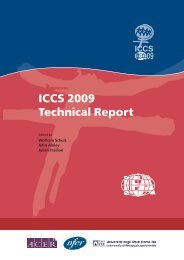International civic and citizenship education study - iccs - IEA
International civic and citizenship education study - iccs - IEA
International civic and citizenship education study - iccs - IEA
- TAGS
- civic
- citizenship
- iccs
- www.iea.nl
You also want an ePaper? Increase the reach of your titles
YUMPU automatically turns print PDFs into web optimized ePapers that Google loves.
The (single-headed) arrow between antecedents <strong>and</strong> processes describes the relationship<br />
between these two types of factors at each level as uni-directional. However, higher-level<br />
processes can influence antecedents, <strong>and</strong> it is likely that, from a long-term perspective, outcomes<br />
may affect variables that are antecedents for learning processes.<br />
Figure 3: Contexts for the development of learning outcomes related to <strong>civic</strong>s <strong>and</strong> <strong>citizenship</strong><br />
Antecedents Processes Outcomes<br />
Wider community<br />
Educational system<br />
History <strong>and</strong> culture<br />
School/classroom<br />
Characteristics<br />
Composition<br />
Resources<br />
Student<br />
Characteristics<br />
Home environment<br />
Family background<br />
Social group<br />
ICCS ASSeSSment FrAmework<br />
Wider community<br />
Educational policies<br />
Political events<br />
School/classroom<br />
Instruction<br />
Governance<br />
Student<br />
Socialization <strong>and</strong><br />
learning<br />
Home environment<br />
Communication<br />
Activities<br />
Indicators related to<br />
Civic society <strong>and</strong> systems<br />
Civic principles<br />
Civic participation<br />
Civic identities<br />
This general contextual framework for ICCS makes it possible to map variables for which data<br />
are collected on a three-by-four grid, with antecedents, processes, <strong>and</strong> outcomes as columns,<br />
<strong>and</strong> the levels of nation/community, school/classroom, student, <strong>and</strong> home environment as<br />
rows. Although the last column for outcomes is not split into levels, it is important to recognize<br />
that, for the analysis, aggregates can also be used at country <strong>and</strong> school/classroom levels. 6<br />
Table 2 maps examples of potential variables (or groups of variables) collected with different<br />
ICCS instruments to each cell in this grid. Variables related to the context of nation/community<br />
are collected primarily through the national context survey <strong>and</strong> other possible data sources.<br />
Variables related to the context of schools <strong>and</strong> classrooms are collected through the school<br />
<strong>and</strong> teacher questionnaires. The student background questionnaire provides information on<br />
antecedents of the individual student <strong>and</strong> the home environment. It also provides information<br />
about process-related variables (for example, learning activities). The student test <strong>and</strong> the<br />
student perceptions questionnaire collect data on outcomes. In addition, the student background<br />
questionnaire includes questions regarding student participation in <strong>civic</strong>-related activities, which<br />
are also used as indicators of active <strong>citizenship</strong> related to Content Domain 3 (<strong>civic</strong> participation).<br />
Some potential variables that can be measured at one level pertaining to another level are<br />
not included in the mapping. Student observations of learning practices in the classroom<br />
can be aggregated <strong>and</strong> used as classroom or school variables. Student, school, <strong>and</strong> teacher<br />
questionnaires might also provide <strong>civic</strong>-related information about the context of the local<br />
community.<br />
6 Note that similar conceptualizations have been used for the planning of other international studies (see, for example,<br />
Harvey-Beavis, 2002; OECD, 2005; Travers, Garden, & Rosier, 1989; Travers & Westbury, 1989).<br />
31

















